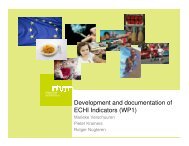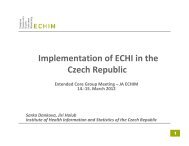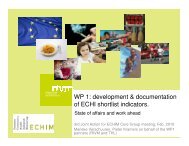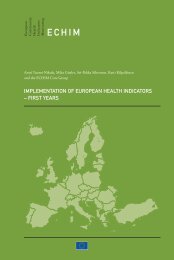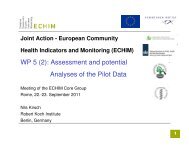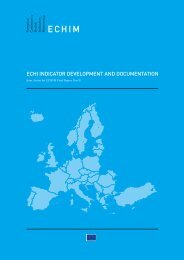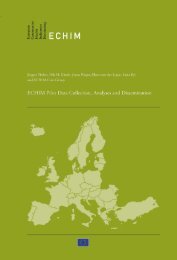INDICATORS
ECHIM Final Report
ECHIM Final Report
Create successful ePaper yourself
Turn your PDF publications into a flip-book with our unique Google optimized e-Paper software.
39. Psychological well-being – ADDED<br />
Definition, comments connected to the proposed additions or major changes: Definition is clear: it<br />
implies the Energy-vitality scale from the SF-36 questionnaire, which is also included in the EHIS. Data<br />
available for about half the EU. Included in this development section because Eurostat considers revising<br />
the instrument, together with the indicator 38. Psychological distress.<br />
Origin and rationale of selection: Indicator suggested by WP Mental Health and MINDFUL project, as<br />
a core item to cover the mental health issue.<br />
53. Work-related health risks – MOVED<br />
Definition, comments connected to the proposed additions or major changes: Moved to development<br />
section to stimulate work on further precise definition of feasible indicators. This cluster originally would<br />
include 1) subjective risk assessments (data European Survey on Working Conditions), 2) physical/<br />
psychological working conditions (survey data) and 3) job transitions (survey data).<br />
Origin and rationale of selection: Originally suggested by NCA, Working Party Mental Health,<br />
Workhealth project. Workplace conditions are important for health.<br />
57. Influenza vaccination rate for elderly – ADDED<br />
Definition, comments connected to the proposed additions or major changes: Defined as the<br />
proportion of the population over 65 receiving influenza vaccination in a given year. OECD presented<br />
data for 22 member countries.<br />
Origin and rationale of selection: This indicator was proposed by ECHIM on the basis of its inclusion<br />
in the OECD Health Care Quality Indicators and its importance for reducing the disease burden by<br />
influenza. It was rated very high in the selection process.<br />
60. Colon cancer screening – ADDED<br />
Definition, comments connected to the proposed additions or major changes: Data collection is not<br />
regular, in view of different national policies; can be assessed by Eurobarometer.<br />
Origin and rationale of selection: Indicator suggested by DG SANCO, as related to EU prevention<br />
policy.<br />
61. Timing of first antenatal visits among pregnant women – ADDED<br />
Definition, comments connected to the proposed additions or major changes: Indicator needs<br />
development of operational definition.<br />
Origin and rationale of selection: Indicator suggested by WP Lifestyles and Peristat project, as a<br />
comprehensive indicator for the adequacy of the important area of perinatal care. Rated rather high in<br />
selection process.<br />
78. Survival rates cancer – CHANGED<br />
Definition, comments connected to the proposed additions or major changes: To include incidence of:<br />
all cancers (without non-melanoma skin), lung, breast, colorectal, prostate, stomach, melanoma, cervical,<br />
leukaemias/lymphomas, all childhood. If a cancer register is present, these data will all be available. OECD<br />
health care quality project: 5-years observed and relative survival rates. IARC, cancer registers.<br />
Origin and rationale of selection: The WP Mortality/morbidity suggested the extension from only<br />
cervical and breast cancer to nine specific cancers and all cancers combined, arguing the importance of<br />
these additional cancers in terms of disease burden and possibilities for improvement of prevention and<br />
treatment.<br />
79. 30-day in-hospital case-fatality AMI and stroke – ADDED<br />
Definition, comments connected to the proposed additions or major changes: Defined as proportion<br />
of deaths in hospital within 30 days after admission with primary diagnosis ICD-10 I21, I22 (AMI),<br />
I61–I64 (stroke), among all such admissions. OECD reported data for 23–24 countries. EUPHORIC<br />
project proposes slightly different definition for AMI survival.<br />
Origin and rationale of selection: Indicator proposed by the WP Mortality/morbidity and Eurociss<br />
project. Rather high rating in selection process. Also in the OECD Health Care Quality Indicators. Good<br />
indicator for the adequacy of AMI and stroke treatment, for AMI especially in the acute phase.<br />
85



